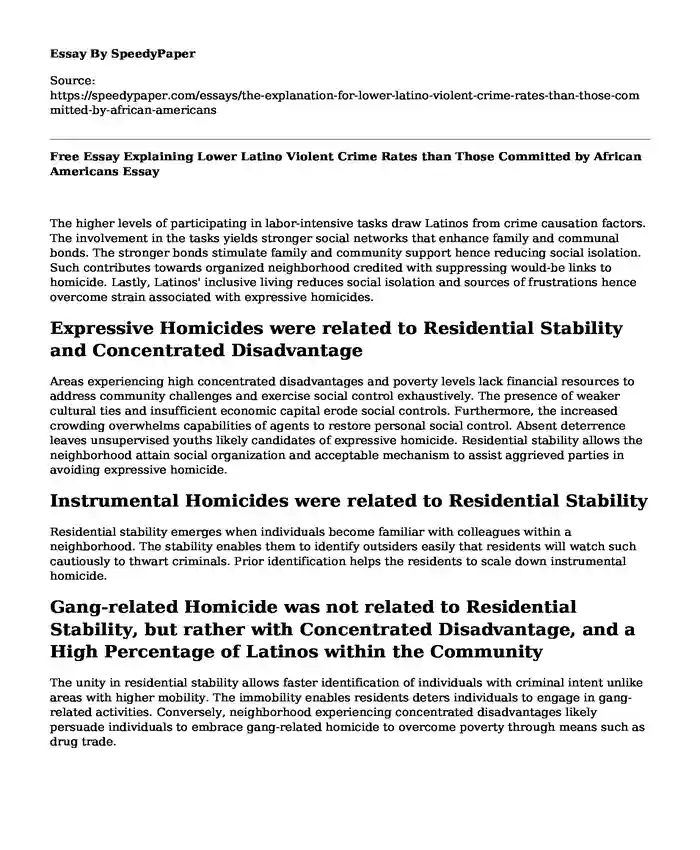
| Type of paper: | Essay |
| Categories: | Violence Criminal law |
| Pages: | 3 |
| Wordcount: | 650 words |
The higher levels of participating in labor-intensive tasks draw Latinos from crime causation factors. The involvement in the tasks yields stronger social networks that enhance family and communal bonds. The stronger bonds stimulate family and community support hence reducing social isolation. Such contributes towards organized neighborhood credited with suppressing would-be links to homicide. Lastly, Latinos' inclusive living reduces social isolation and sources of frustrations hence overcome strain associated with expressive homicides.
Expressive Homicides were related to Residential Stability and Concentrated Disadvantage
Areas experiencing high concentrated disadvantages and poverty levels lack financial resources to address community challenges and exercise social control exhaustively. The presence of weaker cultural ties and insufficient economic capital erode social controls. Furthermore, the increased crowding overwhelms capabilities of agents to restore personal social control. Absent deterrence leaves unsupervised youths likely candidates of expressive homicide. Residential stability allows the neighborhood attain social organization and acceptable mechanism to assist aggrieved parties in avoiding expressive homicide.
Instrumental Homicides were related to Residential Stability
Residential stability emerges when individuals become familiar with colleagues within a neighborhood. The stability enables them to identify outsiders easily that residents will watch such cautiously to thwart criminals. Prior identification helps the residents to scale down instrumental homicide.
Gang-related Homicide was not related to Residential Stability, but rather with Concentrated Disadvantage, and a High Percentage of Latinos within the Community
The unity in residential stability allows faster identification of individuals with criminal intent unlike areas with higher mobility. The immobility enables residents deters individuals to engage in gang-related activities. Conversely, neighborhood experiencing concentrated disadvantages likely persuade individuals to embrace gang-related homicide to overcome poverty through means such as drug trade.
Strain Theory
Strain theory argues that socio-economic structures and processes imposes pressure to achieve the recognizable goals, thereby compels individuals to seek alternative avenues to accomplish such success and standards. The pressure to attain the socially accepted goals causes strain that draws them into committing crimes. Strain arises from negative relationship hindering one from accomplishing the positively valued goals, threaten to eliminate positive stimuli and present negative stimuli. Strain emerges as failure to accomplish goals the society values positively hence conflicting expectations. Secondly, it arises in the presentation of negative stimuli or elimination of positive stimuli.
Traditional Social Disorganization Variables
The traditional social variables associated with youth violence include residential mobility, population density, ethnic heterogeneity, poverty and disruption within the family units causing female-headed households.
Social Disorganization Variable was Associated with Youth Violence in Rural Areas
Youth violence in rural areas emerges from social disorganization caused by structural antecedents including eroded community cohesion and disruptions within the family. Disruptions eroding cohesion alongside forms of community organization facilitate youth violence in the rural areas.
The Purpose of Marwah & Deflem's (2006) Article
The article responds to the recent criticism levied against the Mertonian theory of deviant behavior. It article addresses the misunderstandings by arguing for the visionary sociological model to reveal the contributions by Robert Merton. Besides, it supports clarity to overcome the impaired understanding is possible by identifying and testing different aspects of the anomie-and-opportunity-structures model. The article shows that appropriate conceptualization of the model would help reveal the input of Merton's project in studying deviant behavior.
Theories Contribute to our Overall Understanding of Crime and Criminality
Their contribution eases understanding on why people commit the crime while others refrain from such acts. The contrast in the theories reveals that though all individuals are tempted to engage in criminal behavior, there exist internal protective structures. Additionally, they demonstrate society has containments whose optimization would insulate individuals from factors influencing deviance behavior. How Readings relate to the Class Materials
The readings contribute the relevant explanation of criminality by advancing the understanding why individuals commit certain crimes. They capture illustrations of crime causation from socio disorganization factors, institutional breakdown, socio-economic and contextual factors. They demonstrate the possibility of nondelinquent adaptations to overcome social disorganization causing deviance and criminal conduct.
Cite this page
Free Essay Explaining Lower Latino Violent Crime Rates than Those Committed by African Americans. (2022, Apr 07). Retrieved from https://speedypaper.net/essays/the-explanation-for-lower-latino-violent-crime-rates-than-those-committed-by-african-americans
Request Removal
If you are the original author of this essay and no longer wish to have it published on the SpeedyPaper website, please click below to request its removal:
- Essay Sample: Investigation of the Determinants of Air Pollution
- Essay Sample Assessing and Analyzing the Leadership Style of President Obama
- Free Essay on Competitor Analysis: Determining the Objectives of the Competitors
- Essay Example: Effects of the Use of Nanotechnology in Concrete
- Free Essay: LASA Conflict Management Report
- The Relationship Between Freaks and Norms, Literary Essay Sample
- Topic of the Essay Sample: Patient Education on Diabetes Management
Popular categories




